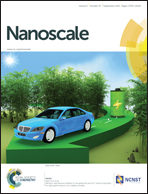The biomolecular corona of nanoparticles in circulating biological media†
Abstract
When nanoparticles come into contact with biological media, they are covered by a biomolecular ‘corona’, which confers a new identity to the particles. In all the studies reported so far nanoparticles are incubated with isolated plasma or serum that are used as a model for protein adsorption. Anyway, bodily fluids are dynamic in nature so the question arises on whether the incubation protocol, i.e. dynamic vs. static incubation, could affect the composition and structure of the biomolecular corona. Here we let multicomponent liposomes interact with fetal bovine serum (FBS) both statically and dynamically, i.e. in contact with circulating FBS (≈40 cm s−1). The structure and composition of the liposome–protein corona, as determined by dynamic light scattering, electrophoretic light scattering and liquid chromatography tandem mass spectrometry, were found to be dependent on the incubation protocol. Specifically, following dynamic exposure to FBS, multicomponent liposomes were less enriched in complement proteins and appreciably more enriched in apolipoproteins and acute phase proteins (e.g. alpha-1-antitrypsin and inter-alpha-trypsin inhibitor heavy chain H3) that are involved in relevant interactions between nanoparticles and living systems. Supported by our results, we speculate that efficient predictive modeling of nanoparticle behavior in vivo will require accurate knowledge of nanoparticle-specific protein fingerprints in circulating biological media.



 Please wait while we load your content...
Please wait while we load your content...